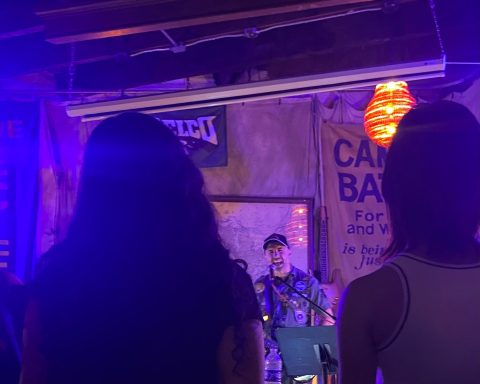Ava Cotlowitz ‘15 is one of the most promising young painters at Swarthmore right now. Beginning at a young age, she has studied classical traditions of art, followed by more experimental techniques in high school, and recently, she’s transferred from Bryn Mawr—which lacks an art department—to continue her studies and maturation as an artist.
I had the pleasure of working alongside Ava last year in Figure Composition, a class that explored the human form, along with the composition and the structures required to create a work in oils. Among my classmates, her work stood out for its vivid use of color and immediately recognizable sense of individual style. While I sloshed around paint, trying to understand how to mix colors in oils, she worked slowly and methodically, creating paintings in a variety of dimensions that reminded me of the sun-glazed texture of David Hockney works. Her rendering of flesh tones alone evokes awe.
I was extremely pleased to be able to interact with her and her works again for this profile and interview. In person, Ava is impeccably attired and sweet-natured, with large, dark eyes that hold mine as she confidently discusses her art.
Deborah Krieger: For my first question, how did you get started making art?
Ava Cotlowitz: Well, I’ve been making art ever since I was little, just as a hobby. Then, after creating art for a very long time… I began to really want to pursue it as a more in-depth passion, so I enrolled in a fine arts school, and, at the age of twelve, I started becoming classically trained in painting…that’s how I got my start.
DK: So in terms of fellow artists, artists you look up to, themes in your life, teachers you’ve had, what’s really inspired you?
AC: I’m definitely inspired by a lot of artists, especially artists that do portraiture and figure drawing and painting. So, specifically, Norman Rockwell, Alice Neel, and Philip Pearlstein… I also really love a lot of Abstract Expressionist Art, like Robert Rauschenberg and Jasper Johns. I like to follow new contemporary artists as well who are not as mainstream as those we’d find in galleries and museums, but are always coming up with new, fresh ideas.
DK: For example?
AC: Adrian Patout and Ivan Alifan are some of my favorites. I’d also say that I’m really inspired by my interactions with people. When I create art, I love finding the psychology in the subject matter that I’m working with, so if I’m painting a face or a figure, I’m really interested in exploring the dynamics of expression and how the contrast between lights and darks evoke certain moods and tones.
DK: Are you looking to go into art as a career and do it professionally?
AC: I want to paint professionally for as long as I can, but what I’m really excited about pursuing is a career in Arts Education, so I’m either hoping to become an elementary school art teacher and/or [to] work within the education department of a fine art museum and bring art to students of all ages.
DK: That’s great! If you weren’t making art, what would you be doing? What are your other interests?
AC: Well, I teach all the time. I teach preschool at [The Haverford School] three days a week and I teach art lessons once a week at Overbrook Elementary School, and I also love to sketch, which, I guess, is still in line with creating art! When I have chance, I’ll go to an art museum or gallery exhibition.
DK: So you transferred from Bryn Mawr this year. What was it about Swarthmore’s Art program in particular that made you want to study here?
AC: Bryn Mawr did not have an art program, so for my first two years of college I had to take art classes at Haverford College. I found that the art program there was lacking a community of artists that I felt in sync with, as well as instruction that I thought was in line with how I desired to learn as an artist. So I decided to take two art classes at Swarthmore and [to] check out the department… I took Landscape Painting and Figure Composition with Randall Exon…
DK: He’s the best!
AC: Yep! I immediately found that Randall became a professor [who] offered more than just a typical student-professor relationship. He became a devoted mentor who really facilitated the growth and development of my personal painting style as well as my own purpose for creating art. [Additionally,] I felt that the students in my art classes at Swarthmore were really committed to not only developing their own artistic identities and visions, but also providing their peers with positive feedback, constructive criticism, and unwavering support.
DK: Yeah, I noticed that in Figure Composition last year…
AC: Yeah!
DK: It was a great environment.
AC: I really felt like my relationships with my peers facilitated my ability to hone my own skills as an artist as well as [my skills at painting] what I desired to paint. It definitely felt like the right place to be.
DK: What has been a really important challenge for you in terms of growth as an artist? What has been a really important watershed moment in terms of your artistic growth?
AC: When I started pursuing art more seriously, I was taught how to paint classically. So…when I was twelve and thirteen, I [basically] spent each year creating one painting. It really required a lot of focus and self-motivation, especially because the way I painted was so photorealistic and precise. Because that was the way I came into painting as a fine art, it took me a while to accept that my painting did not have to be limited to classical rendering. It wasn’t until high school that I really started experimenting with other forms of art making. At this time, I had enrolled in another art school that focused on developing each student’s artistic identity through constant experimentation. I created large 8 by 7 foot multimedia abstract artworks, I created more realistic portraits, I sculpted and did a lot of figure drawing, so I really got to go all over the board; I think that opened my eyes to the excitement and possibility so inherent in art-making. So, as I’m in college now, I feel prepared to hone my style of creating art in a way that’s in line with my own instincts and desires.
DK: Last year, I noticed that you do a lot of great drip work in your art. Where did that come from? Because that’s very distinctively you.
AC: That’s an interesting question… That definitely stemmed from my experimentation with abstract art in high school. When I paint, there’s not really any rhyme or rhythm to it. Generally, I love painting from a photograph or some kind of tangible source. I don’t necessarily like painting from my imagination. But when it comes to more abstract lines and textures in my work, they are very intuitive. They’re not something you can find in a picture… I would say that when I paint, I’m in a flow. I feel as though I’m completely absorbed in the act of painting and when it comes time to do so, I just let my hand and my mind sync up together and just do whatever [they want]. And from that, dripping has occurred.
DK: What do you hope people who see your work take away from it?
AC: I really hope, especially in my portraits and figure paintings, that people can connect to some sort of underlying psychology about my work… that they can identify with and/or acknowledge a facial expression or body movement that triggers emotion and feeling. My hope is that my work conjures a memory or a sense of something familiar through the interplay of color, composition, and contrast.
















